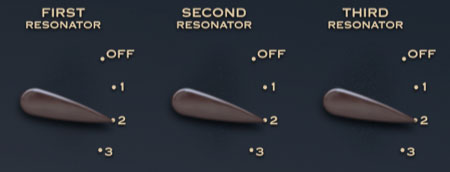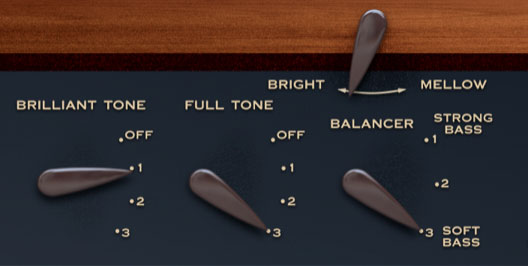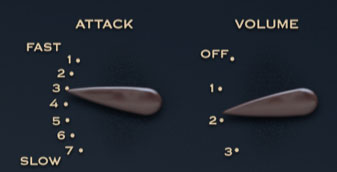
Tone and Resonator Controls
Novachord's tone and resonator settings control various filter types, allowing extensive timbral shaping. Unlike typical analog synthesizer filters, the tone generators' output signals are split and routed in parallel to all of the filters, processed and then summed together to create a composite tone.

Deep Tone- Sets the level of tone generator signal with a one-pole (6dB per-octave slope) lowpass filter with a fixed frequency of 160 Hz applied.
Resonators

The three resonators are bandpass filters, operating consecutively in low, mid, high frequency ranges.
First Resonator level and frequency- The lever controls the volume of the resonator. The bandpass filter frequency is 400 Hz.
Second Resonator level and frequency- The lever controls the volume of the resonator. The bandpass filter frequency is 800 Hz.
Third Resonator level and frequency- The lever controls the volume of the resonator. The bandpass filter frequency is 2000 Hz.

Brilliant Tone- Sets the level of tone generator signal with a one-pole (6dB per-octave slope) highpass filter with a fixed frequency of 2000 Hz applied.
Full Tone- This actually isn't a filter at all - it simply controls the amplitude of the dry (no filters applied) tone generator signal. This is important because the filters can be reedy by nature (yeah, you know them).
Bright/Mellow- A one-pole lowpass filter affecting overall instrument brightness. This was a two-position switch on the original instrument, but we've made it a continuously variable control.
Balancer- Adjusts volume tracking between the lower and upper ranges of the keyboard. Moving the lever downward toward Soft Bass causes lower notes to become quieter and higher notes to get louder; moving the lever upward toward Strong Bass causes lower notes to get louder and higher notes to become quieter.

Attack- Unlike a typical synthesizer ADSR-style attack control that only affects the onset of the amplitude curve, Novachord's Attack lever shapes attack, decay, and sustain amplitude characteristics (release is "instant-off" like an organ at all settings).
The Attack control's seven fixed settings range from a percussive, piano amplitude (1) curve up to a slow, sustaining shape (7).
When a sustain pedal is used, a fixed release time of around 3.5 seconds is added to note releases.
Volume- Sets overall instrument volume.
Note that Novachord responds to MIDI Expression (CC 11) to emulate the Novachord's volume pedal.

Vibrato- Enables the Novachord's unique vibrato circuit. Vibrato I uses square-wave modulation, as used in the earliest Novachord models; Vibrato II makes use of a more rounded-off square wave, as used in later Novachords.
Vibrato Depth- Sets the modulation range of the vibrato with three preset depths.
Reverb- Sets the amount of either a room-style reverb (lever up) or a larger hall-style reverb (lever down).
Limiter- Flipping the toggle up engages a gentle limiter that helps avoid overloading when playing louder sounds. The amber lamp above illuminates to show the limiter is engaged. The lamp glows red when peaking - if this happens, back off the Volume control (or stop playing chords with your elbows).
Novachord... In A Room, With a Speaker
It's important to remember that unlike modern keyboard instruments, the Novachord didn't have a direct output jack of any kind - instead, it had a built-in 1930's-era tube amplifier and speakers. With this mind, we emulated its amp+speaker combo, and we strongly advise using one of the reverbs at all times, because it was alway heard "in a room" of some sort.